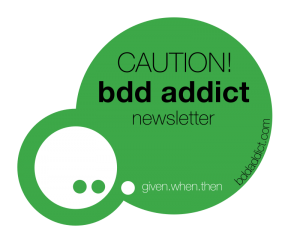The monthly dose for BDD addicts… In August stories by Gojko Adzic, Hiptest team, Liz Keogh, Andy Knight & Markus Oberlehner …
Subscribe to the monthly newsletter at http://bddaddict.com so that you never miss it! (Did you get the June-July issue?)
Dear BDD Addicts,
You are probably back form the summer holidays. Busy days are coming for me. I will be travelling a lot in autumn. Most of them will be training courses but I am also going to attend some conferences: HUSTEF (Budapest), P3X (London) and Agile Testing Days (Potsdam). Would be great to talk to other BDD addicts there, so if you should plan to come, please drop me a mail at bddaddict@specsolutions.eu, for some of confs I even have discount coupons that I can share with you.
But if you don’t come, you can still email me whenever you see an interesting article about BDD, Cucumber, SpecFlow, or agile testing and test automation.
But now, let’s jump into the monthly dose…

Source_ unsplash.com (by Efe Kurnaz)
[Agile] Sustainable products: Sprints vs. marathons
Probably when you hear about sprints and marathons in the context of software development, you would think about the classic waterfall vs. agile discussion. Sprints represent the agile iterations and marathons the long waterfall ones. It is what we have learned from the running metaphor. But wait! How many sprints can a runner run without having a rest? A recent article by Gojko Adzic digs into this metaphor to understand how we can deal with code maintenance, refactoring story and other technical improvements in an agile project.
Sprints, marathons and root canals (Gojko Adzic, @gojkoadzic)

Source: unsplash.com (by Goh Rhy Yan)
[BDD] State of Behavior Driven Development 2018
You are a BDD addict. But how many others are out there? What are they doing? What are their plans? The “State of Behavior Driven Development 2018” report results have been just published by Hiptest. Based on their study, the percentage of teams using BDD has increased from 38% (2017) to 44% (2018)! The two main benefits these teams see from using BDD are increased quality and better collaboration. And how many of them use automated tests? Check out the report yourself!
State of Behavior Driven Development 2018 – The results! (Hiptest team, @Hiptest_agile)
[Tooling] BDD in Visual Studio Code
Visual Studio Code is a free cross platform IDE from Microsoft. Besides the name and some common concepts it has nothing in common with Visual Studio. VS Code is written in JavaScript and primarily targets node.js developers, but it supports many other languages and platforms as well. Andy Knight checked how it can be used for editing Gherkin files.
Gherkin Syntax Highlighting in Visual Studio Code (Andy Knight, @AutomationPanda)
[BDD] Then inside the Given?
When using the words “assertion”, “check”, “verification” or “Then [step]”, we usually imagine a line in the automation codebase that checks a condition. If the condition is not met, it throws an exception and makes the test fail. Coming from this picture, people often get confused about where such assertions can be performed. It is clear that we do them in “Then” steps, but can they also be done in “Given” or “When” steps. (There is a similar discussion about whether we can put them into page objects or not.) I think this confusion is rooting in the fact that we see all assertions equal and don’t think about why we make that verifications. Liz Keogh has given a good summary about this topic on Stack Overflow.
Stack Overflow: Should Assertions be performed in BDD Given and When (Liz Keogh, @lunivore)
[Cucumber.js] Super-fast integration tests
When arranging tests on the test automation pyramid, people usually think only about the extent of the user journey the test covers. End-to-end tests cover a full user journey, service level tests just a step of that and unit tests just a tiny portion that is implemented by a single unit. But to get fast feedback (that should be our overall goal), there are other techniques as well, like cutting off external dependencies and replacing them with stubs. Markus Oberlehner shows an example for that on JavaScript with Cucumber.js.
Network Stubs and Timers with Nightwatch.js and Cucumber.js(Markus Oberlehner, @MaOberlehner)



